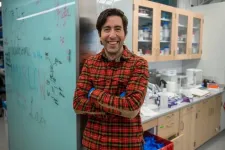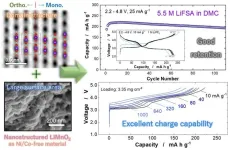(Press-News.org) Over 12,000 feet below the surface of the sea, in a region of the Pacific Ocean known as the Clarion-Clipperton Zone (CCZ), million-year-old rocks cover the seafloor. These rocks may seem lifeless, but nestled between the nooks and crannies on their surfaces, tiny sea creatures and microbes make their home, many uniquely adapted to life in the dark.
These deep-sea rocks, called polymetallic nodules, don’t only host a surprising number of sea critters. A team of scientists that includes Boston University experts has discovered they also produce oxygen on the seafloor.
The discovery is a surprise considering oxygen is typically created by plants and organisms with help from the sun—not by rocks on the ocean floor. About half of all the oxygen we breathe is made near the surface of the ocean by phytoplankton that photosynthesize just like land-dwelling plants. Since the sun is needed to carry out photosynthesis, finding oxygen production at the bottom of the sea, where there is no light, flips conventional wisdom on its head. It was so unexpected that scientists involved in the study first thought it was a mistake.
“This was really weird, because no one had ever seen it before,” says Jeffrey Marlow, a BU College of Arts & Sciences assistant professor of biology and coauthor on the study, which was published in Nature Geoscience.
As an expert in microbes that live in the most extreme habitats on Earth—like hardened lava and deep-sea hydrothermal vents—Marlow initially suspected that microbial activity could be responsible for making oxygen. The research team used deep-sea chambers that land on the seafloor and enclose the seawater, sediment, polymetallic nodules, and living organisms. They then measured how oxygen levels changed in the chambers over 48 hours. If there are plentiful organisms breathing oxygen, then the levels would normally decline, depending on how much animal activity is present in the chamber. But in this case, oxygen was increasing.
“We did a lot of troubleshooting and found that the oxygen levels increased many more times following that initial measurement,” Marlow says. “So we’re now convinced it’s a real signal.”
He and his colleagues were aboard a research vessel tasked with learning more about the ecology of the CCZ, which spans 1.7 million square miles between Hawaii and Mexico, for an environmental survey sponsored by The Metals Company, a deep-sea mining firm interested in extracting the rocks en masse for metals. After running experiments on board the vessel, Marlow and the team, led by Andrew Sweetman at the Scottish Association for Marine Science, concluded the phenomenon isn’t primarily caused by microbial activity, despite the abundance of many different types of microbes both on and inside the rocks.
Polymetallic nodules are made of rare metals, including copper, nickel, cobalt, iron, and manganese, which is why companies are interested in mining them. It turns out, according to the study, that those densely packed metals are likely triggering “seawater electrolysis.” This means that metal ions in the rock layers are distributed unevenly, creating a separation of electrical charges—just like what happens inside of a battery. This phenomenon creates enough energy to split water molecules into oxygen and hydrogen. They named this “dark oxygen,” since it’s oxygen made with no sunlight. What remains unclear is the exact mechanism of how this happens, if oxygen levels vary across the CCZ, and if the oxygen plays a significant role in sustaining the local ecosystem.
The Metals Company calls polymetallic nodules a “battery in a rock,” and on its website states that mining them could accelerate the transition to battery-powered electric vehicles and claims mining on land would eventually no longer be necessary. So far, mining in the CCZ is exploratory, but the United Nations International Seabed Authority, which manages the area, could start making decisions about mining as soon as next year. The Metals Company is working with the Pacific states of Nauru, Tonga, and Kiribati to gain access to mining licenses, but many other nations in the South Pacific, including Palau, Fiji, and Tuvalu, have vocally supported a moratorium or a pause to mining plans. Environmental activist groups like Greenpeace and Ocean Conservancy are calling for a permanent ban, and opponents of the operation fear it could cause irreversible damage to the seafloor.
In the meantime, scientists have begun studying the potential impacts of disturbing a largely unexplored ecosystem. This Nature Geoscience paper contributes insights about the baseline conditions of the area before any large-scale mining begins.
“We don’t know the full implications, but to me this finding suggests that we should deeply consider what altering these systems would do to the animal community,” Marlow says, since all animals need oxygen to survive.
The CCZ is also the perfect environment to study the planet’s smallest organisms, such as bacteria and archaea (single-celled organisms) found in sediments and on the nodules. Marlow and his coauthor Peter Schroedl (GRS’25), a PhD student in BU’s ecology, behavior, and evolution program, are especially focused on using microbes found in extreme environments like the CCZ as templates for finding single-celled life on other planets and moons—since deserts, volcanoes, and seafloor vents are the most similar places we have to Mars and Saturn’s many moons. This is called astrobiology, a field that seeks to inform the search for extraterrestrial life by studying Earth’s systems.
“Life in environments like the CCZ provides an opportunity to study ecosystems that developed under distinct evolutionary pressures and constraints,” says Schroedl, who works in Marlow’s lab. Those conditions—the depth, pressure, and aquatic environment—are “analogous to conditions we have measured or expect to discover on icy moons,” he says.
For example, Jupiter’s moon, Enceladus, and Saturn’s moon, Europa, are covered with layers of ice with no sunlight reaching that water trapped underneath. “Who knows—if these types of rocks are under the ice making oxygen, that could allow a more productive biosphere to exist,” Marlow says. “If photosynthesis isn’t required to make oxygen, then other planets with oceans and metal-rich rocks like these nodules could sustain a more evolved biosphere than we’ve thought possible in the past.”
There are plenty of questions to continue asking, Marlow says, about what the dark oxygen discovery means for extraterrestrial oceans and our own.
“For the most part, we think of the deep sea as a place where decaying material falls down and animals eat the remnants. But this finding is recalibrating that dynamic,” he says. “It helps us to see the deep ocean as a place of production, similar to what we have found with methane seeps and hydrothermal vents that create oases for marine animals and microbes. I think it’s a fun inversion of how we tend to think about the deep sea.”
Republishers are kindly reminded to uphold journalistic integrity by providing proper crediting, including a direct link back to the original source URL here.
END
Marine science oxygen produced in the deep sea raises questions about extraterrestrial life
BU researchers helped make startling discovery: rocks are generating “dark oxygen” in an area being explored for deep-sea mining
2024-08-26
ELSE PRESS RELEASES FROM THIS DATE:
What microscopic fossilized shells tell us about ancient climate change
2024-08-26
At the end of the Paleocene and beginning of the Eocene epochs, between 59 to 51 million years ago, Earth experienced dramatic warming periods, both gradual periods stretching millions of years and sudden warming events known as hyperthermals.
Driving this planetary heat up were massive emissions of carbon dioxide (CO2) and other greenhouse gases, but other factors like tectonic activity may have also been at play.
New research led by University of Utah geoscientists pairs sea surface temperatures with levels ...
Li-ion batteries show promise as cheap and sustainable alternative to Ni/Co materials
2024-08-26
Lithium-ion (or Li-ion) batteries are heavy hitters when it comes to the world of rechargeable batteries. As electric vehicles become more common in the world, a high-energy, low-cost battery utilizing the abundance of manganese (Mn) can be a sustainable option to become commercially available and utilized in the automobile industry. Currently, batteries used for powering electric vehicles (EVs) are nickel (Ni) and cobalt (Co)-based, which can be expensive and unsustainable for a society with a growing desire for EVs. By switching the positive electrode ...
The Lundquist Institute announces updates to its Board of Directors
2024-08-26
The Lundquist Institute for Biomedical Innovation at Harbor-UCLA Medical Center (TLI) announced updates to its Board of Directors today. TLI welcomes one new distinguished member and thanks the two outgoing members for their invaluable contributions.
“On behalf of the Board, I am delighted that Dr. Bill Dorfman, a global leader in cosmetic dentistry, has joined the TLI Board. Dr. Dorfman's extensive expertise and commitment to philanthropy make him an invaluable addition to our leadership,” said Mitchel Sayare, PhD, TLI Board ...
Research from UTHealth Houston finds parents who recently experienced intimate partner violence had higher potential for parenting stress and child maltreatment
2024-08-26
Parents who recently experienced intimate partner violence reported more parenting stress and higher potential for child maltreatment, and were less likely to use positive parenting strategies, according to UTHealth Houston research published Aug. 26, 2024, in JAMA Pediatrics.
“Our findings demonstrate the collateral damage of domestic violence — that the negative consequences are not limited to the couple and instead have the potential to affect how they parent, and ultimately the health of their children. We must expend every effort to prevent this public health problem,” said Jeff Temple, PhD, ...
Research spotlight: Key regulators of pd-1 in melanoma cells and the immune system’s response
2024-08-26
How would you summarize your study for a lay audience?
Immune checkpoint inhibitors are cancer fighting drugs that help the immune system do its job of detecting and attacking tumor cells. Programmed Cell Death 1 (PD-1) is a common target for this type of drug—it is a protein that sits on the surface of T cells and helps regulate the immune system’s response to neighboring cells, both normal and cancerous. While most research efforts to date have focused on PD-1’s role in T cells, it is also active in many other kinds of cells—including cancer cells as first demonstrated by the Schatton ...
Lighting the way for quantum innovation
2024-08-26
ALBUQUERQUE, N.M. — Sandia National Laboratories and Arizona State University, two research powerhouses, are collaborating to push the boundaries of quantum technology and transform large-scale optical systems into compact integrated microsystems.
Nils Otterstrom, a Sandia physicist specializing in integrated photonics, is at the forefront of scaling down optical systems to the size of a chip. This innovation offers performance advantages and scalability for an array of applications from advanced computing to secure communications.
“Integrated ...
Spin squeezing for all
2024-08-26
Nothing in science can be achieved or understood without measurement. Today, thanks to advances in quantum sensing, scientists can measure things that were once impossible to even imagine: vibrations of atoms, properties of individual photons, fluctuations associated with gravitational waves.
A quantum mechanical trick called “spin squeezing” is widely recognized to hold promise for supercharging the capabilities of the world’s most precise quantum sensors, but it’s been notoriously difficult to achieve. In new research, Harvard physicists describe how they’ve put spin squeezing ...
NSF funds research on the effects of evolution and food webs in climate change response
2024-08-26
Colorado State University is leading a new interdisciplinary research project into the ways predators and prey in sensitive ecosystems may react to climate change based on their physiology, genetics and relationships to each other.
Led by Professor Chris Funk in the Department of Biology, the project is funded by the National Science Foundation’s Organismal Response to Climate Change program and will focus on interactions between cutthroat trout and tailed frogs in Pacific Northwest streams. This approach is one of the first times researchers have tried to test both the effects of evolution and ...
Children's Brain Tumor Network hosts 2024 CBTN Summit to transform scientific research and patient care
2024-08-26
What:
The 2024 CBTN Summit hosted by the Children's Brain Tumor Network (CBTN) assembles the brightest minds in Pediatric Brian Tumor research for this annual conference. The event is free but attendees must register in advance.
Register at network.cbtn.org/cbtn-summit
Where:
In person at AWS Headquarters
Amazon WAS16 Aurora, 1770 Crystal Dr, Arlington, VA 22202
Virtual attendance available worldwide.
When:
October 9-11, 2024
Why:
This event is an opportunity ...
Long-term prognosis of patients with myocarditis attributed to COVID-19 mRNA vaccination, SARS-CoV-2 infection, or conventional etiologies
2024-08-26
About The Study: Patients with post–COVID-19 mRNA vaccination myocarditis, contrary to those with post–COVID-19 myocarditis, show a lower frequency of cardiovascular complications than those with conventional myocarditis at 18 months. However, affected patients, mainly healthy young men, may require medical management up to several months after hospital discharge.
Corresponding Authors: To contact the corresponding authors, email Laura Semenzato, MSc (laura.semenzato@assurance-maladie.fr) and Mahmoud Zureik, MD, PhD (Mahmoud.ZUREIK@ansm.sante.fr).
To access the embargoed study: Visit our For The ...
LAST 30 PRESS RELEASES:
Numbers in our sights affect how we perceive space
SIMJ announces global collaborative book project in commemoration of its 75th anniversary
Air pollution exposure and birth weight
Obstructive sleep apnea risk and mental health conditions among older adults
How talking slows eye movements behind the wheel
The Ceramic Society of Japan’s Oxoate Ceramics Research Association launches new international book project
Heart-brain connection: international study reveals the role of the vagus nerve in keeping the heart young
Researchers identify Rb1 as a predictive biomarker for a new therapeutic strategy in some breast cancers
Survey reveals ethical gaps slowing AI adoption in pediatric surgery
Stimulant ADHD medications work differently than thought
AI overestimates how smart people are, according to HSE economists
HSE researchers create genome-wide map of quadruplexes
Scientists boost cell "powerhouses" to burn more calories
Automatic label checking: The missing step in making reliable medical AI
Low daily alcohol intake linked to 50% heightened mouth cancer risk in India
American Meteorological Society announces Rick Spinrad as 2026 President-Elect
Biomass-based carbon capture spotlighted in newly released global climate webinar recording
Illuminating invisible nano pollutants: advanced bioimaging tracks the full journey of emerging nanoscale contaminants in living systems
How does age affect recovery from spinal cord injury?
Novel AI tool offers prognosis for patients with head and neck cancer
Fathers’ microplastic exposure tied to their children’s metabolic problems
Research validates laboratory model for studying high-grade serous ovarian cancer
SIR 2026 delivers transformative breakthroughs in minimally invasive medicine to improve patient care
Stem Cell Reports most downloaded papers of 2025 highlight the breadth and impact of stem cell research
Oxford-led study estimates NHS spends around 3% of its primary and secondary care budget on the health impacts of heat and cold in England
A researcher’s long quest leads to a smart composite breakthrough
Urban wild bees act as “microbial sensors” of city health.
New study finds where you live affects recovery after a hip fracture
Forecasting the impact of fully automated vehicle adoption on US road traffic injuries
Alcohol-related hospitalizations from 2016 to 2022
[Press-News.org] Marine science oxygen produced in the deep sea raises questions about extraterrestrial lifeBU researchers helped make startling discovery: rocks are generating “dark oxygen” in an area being explored for deep-sea mining








